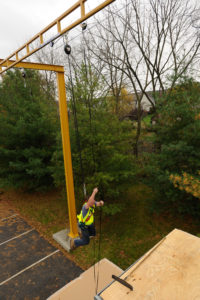Fall Protection Forum
Recent Posts
October 26, 2016
Workplace Falls: The Cost of Doing Business?
According to the National Safety Council, fall injuries contribute to a large percentage of workers’ compensation and medical costs for companies from all types of industries. This cost has been approximated at 70 billion dollars annually in the United States alone. As a result, CFR 1926.501 Fall Protection is the…
October 19, 2016
Suspension Trauma and Rescue for At-Height Workers
This blog was originally posted on 10/19/2016 and reviewed on 3/8/2021. Disclaimer:…
October 12, 2016
Part 4: Fall Protection Procedures: Minimum Requirements for a Managed Fall Protection Program
According to the National Fall Protection Code, ANSI/ASSE Z359.2-2007, fall protection procedures are an essential part of developing minimum requirements for a comprehensive managed fall protection program. Last week we discussed training and evaluation; this week we are going to discuss part four of the series—fall protection procedures and general…
October 5, 2016
Part 3: Training and Evaluation: Minimum Requirements for a Managed Fall Protection Program
Training and evaluations are an essential part of a comprehensive managed fall protection program, especially considering the overall importance of safety and proper training in the workplace. We know, from the American National Standard (ANSI/ASSE Z359.2-2007), that there are a total of nine defined personnel in a comprehensive managed fall…
September 28, 2016
Part 2: Personnel: The Minimum Requirements for a Managed Fall Protection Program
Employers have a lot of duties and responsibilities when it comes to at-height workers. Part two of this four-part blog series covers the responsibilities and functions of different fall protection personnel—following the national standard that determines the minimum requirements for a comprehensive fall protection program—ANSI Z359.2-2007. When reading about fall…
September 22, 2016
Part 1: Employers: The Minimum Requirements for a Managed Fall Protection Program
Employers have a lot of duties and responsibilities when it comes to at-height workers. Part one of this four-part blog series covers the expectations for employers to keep their workers safer at height—following the national standard that determines the minimum requirements for a comprehensive fall protection program—ANSI Z359.2-2007. POLICY STATEMENTS:…
September 15, 2016
Ask Rigid Lifelines: What’s the difference between an engineered system and a non-engineered system?
We receive questions about non-engineered fall protection systems and how they differ from engineered fall protection systems on a regular basis. So, let’s take an in-depth look at their basic differences and the load testing requirements for each. Engineered Fall Protection Systems: An engineered fall protection system is one that…
September 1, 2016
Risk Assessment and Hazard Controls: Ensure Your Workers Are Safe from Unnecessary Risks
Risk assessment is the process of identifying hazards, analyzing or evaluating the risk associated with those hazards, and determining appropriate ways to eliminate or control them. Conducting a risk assessment requires a thorough look at your workplace or factory to identify situations, equipment, machinery, and processes that could potentially cause…
August 4, 2016
Fall Protection for Tanker Trucks, Loading Docks, Flatbed Trucks, and Railcars
The transportation industry often requires workers to climb atop tanker trucks, flatbeds, and even open or closed trailers on a regular basis. It’s often unknown that more people die falling from 20 feet or less than from much higher heights. There are many other risks to transportation professionals, but the…
January 8, 2016
13 Steps to Improve Construction Safety
Unfortunately, construction worker injuries and fatalities are still a major problem. In the US, one in five worker deaths last year were in construction in 2015. The Associated General Contractors (AGC) of America collaborated with the Carolinas Associated General Contractors to release a 13-step plan aimed at reducing construction worker…
December 14, 2015
Ask Rigid Lifelines: What’s the Difference between a Cable System and Your Rigid Anchor Track™ System
Question: What’s the Difference between a Cable System and Your Rigid Anchor Track System? Answer: Although many fall protection solutions are available, safety professionals investing in a fall protection system must choose the right system for their specific application. Safety professionals often tell us, “We like the Rigid Lifelines’ system,…
December 7, 2015
Interactive Hazard Training
Many companies today struggle with getting employee safety training to stick. Most employee training sessions consist of watching professional videos and/or teaching in a classroom setting. Although these traditional methods are effective, employee engagement is often low, resulting in employees retaining less information. Interactive hazard training encourages a higher level…

